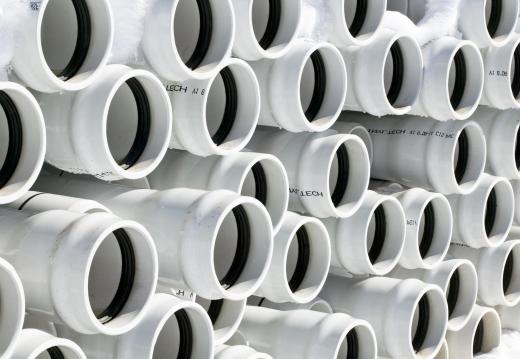A carrier pipe is an inner pipe, or a hollow cylindrical tube contained inside an outer sheath. Responsible for carrying fluids, the carrier pipe runs through an outer, insulated casing that acts as a containment system that protects against spills. Carrier pipes can be made from strong metal, like steel, as well as plastics like polyvinyl chloride (PVC) or fiberglass. The containment pipe surrounding a carrier pipe can be either insulated or hollow. If the containment pipe is hollow, small blocks called spacers situated within the containment pipe help keep the carrier pipe properly aligned within the containment system.
In a protected pipe system that employs a carrier pipe, the outer pipe is often called a containment pipe, a casing pipe, or a protective pipe. This technology is most often used in a type of pipe called the double-walled pipe. In the oil industry, an outer containment pipe that protects an upward-running oil carrier pipe is sometimes called a riser. Some newer technology in carrier and containment piping has produced carrier pipes that are paired with flexible carrier pipes to create bendable pipes designed to move liquids, often oil, between vessels that could be unexpectedly jostled by waves.

Some carrier pipes have two containment pipes or containment pipes with double walls. These systems are called double containment systems. Double containment systems add advanced protection against leakage in pipes carrying hazardous liquids. In some double containment systems, a breach of the inner containment wall triggers an alarm that alerts technicians of the leak. Using a leak notification system in a double-walled pipe helps keep damage from carrier pipe leakage to a minimum by identifying the leak before the outer containment wall is breached.

City water and sewer carrier pipes are housed inside containment pipes, particularly when a pipe is built exposed. Protecting exposed municipal pipes helps stave off corrosion, environmental damage, or vandalism. Many city codes also require all underground pipes to have double containment walls.
In manufacturing, carrier pipes are protected and insulated to keep them from damage or exposure and protect the liquids from changes in temperature. Outer pipes insulate the carrier pipes to keep their liquid contents at a stable and desired temperature. This feature can be important in food processing, where temperatures too high or too low can result in quality problems that can be as serious as food contamination. In the home, water carrier pipes that run through an attic may rest inside protective casing that protects them from changes in temperature.
